The Illustrated Guide To The Shih Tzu Standard | Head
 CONTENTS: Front Cover | Preface | History | Anatomy | Standard | General Appearance | Size, Substance | Proportion | HEAD | Neck, Body | Topline | Tail | Forequarters | Hindquarters | Coat, Trimming, Color, and Markings | Gait
CONTENTS: Front Cover | Preface | History | Anatomy | Standard | General Appearance | Size, Substance | Proportion | HEAD | Neck, Body | Topline | Tail | Forequarters | Hindquarters | Coat, Trimming, Color, and Markings | Gait

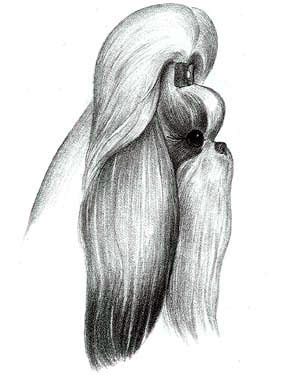 HEAD – Round, broad, wide between eyes, its size in balance with the overall size of dog being neither too large nor too small. [Fault: Narrow head, close-set eyes.] CLARIFICATION: No individual part should take prominence over another. The individual parts of the head should combine to produce a pleasing expression.
HEAD – Round, broad, wide between eyes, its size in balance with the overall size of dog being neither too large nor too small. [Fault: Narrow head, close-set eyes.] CLARIFICATION: No individual part should take prominence over another. The individual parts of the head should combine to produce a pleasing expression.
EXPRESSION – Warm, sweet, wide-eyed, friendly and trusting. An overall well-balanced and pleasant expression supersedes the importance of individual parts. Care should be taken to look and examine well beyond the hair to determine if what is seen is the actual head and expression rather than an image created by grooming technique. CLARIFICATION: The Shih Tzu should never have a hard or stern expression. As the standard specifically outlines, the head should be thoroughly examined by hand to determine the actual size, shape and expression.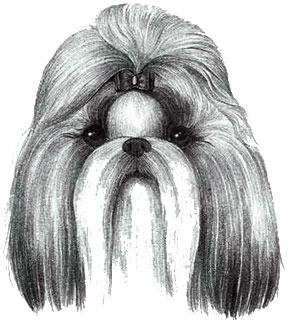 EYES – Large, round, not prominent, placed well apart, looking straight ahead. Very dark. Lighter on liver pigmented dogs and blue pigmented dogs. [Fault: Small, close-set or light eyes; excessive eye white.] CLARIFICATION: A dog may show some eye white, but it should never be so much that it detracts from the warm, sweet expression of the Shih Tzu.
EYES – Large, round, not prominent, placed well apart, looking straight ahead. Very dark. Lighter on liver pigmented dogs and blue pigmented dogs. [Fault: Small, close-set or light eyes; excessive eye white.] CLARIFICATION: A dog may show some eye white, but it should never be so much that it detracts from the warm, sweet expression of the Shih Tzu.
EARS – Large, set slightly below crown of skull; heavily coated. CLARIFICATION: Ears should blend into the head.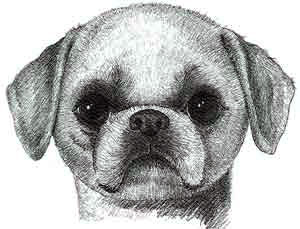 SKULL – Domed. CLARIFICATION: The skull should be well domed and rounded or arched in all directions. The skull should never be flat. The skull should never fall away from the eyes. There should be a good amount of fore skull between and in front of the eyes.
SKULL – Domed. CLARIFICATION: The skull should be well domed and rounded or arched in all directions. The skull should never be flat. The skull should never fall away from the eyes. There should be a good amount of fore skull between and in front of the eyes.
STOP – There is a definite stop. CLARIFICATION: The stop is distinct definition between the skull and the muzzle and should be deep. There is no wrinkle such as that found in a Pug or Pekingese.
MUZZLE – Square, short, unwrinkled, with good cushioning, set no lower than bottom eye rim; never down-turned. Ideally, no longer than 1 inch from tip of nose to stop, although length may vary slightly in relation to overall size of dog. Front of muzzle should be flat; lower lip and chin not protruding and definitely never receding. [Fault: Snipiness, lack of definite stop.] CLARIFICATION: When viewed from the front, the muzzle should form a square, being wide from top to bottom and from side to side. The muzzle should also be viewed from the side to be sure of proper nose-eye placement. Viewed from the side, the muzzle should be perpendicular to the skull. In order to have a square muzzle, it is extremely important for the jaw to be broad or wide. A strong, broad under jaw is integral in creating the proper expression as well as the correct muzzle shape. The muzzle cushioning contributes to the desired “soft” expression.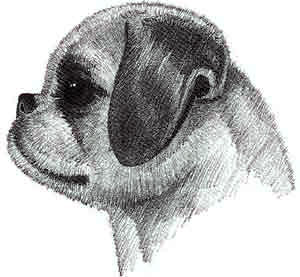 NOSE – Nostrils are broad, wide, and open. CLARIFICATION: It should be noted that the Shih Tzu is a Brach cephalic breed with a tendency for the nostrils to be pinched. Therefore it is very important that a Shih Tzu have the desired broad, wide, and open nostrils in order to have sufficient capacity.
NOSE – Nostrils are broad, wide, and open. CLARIFICATION: It should be noted that the Shih Tzu is a Brach cephalic breed with a tendency for the nostrils to be pinched. Therefore it is very important that a Shih Tzu have the desired broad, wide, and open nostrils in order to have sufficient capacity.
PIGMENTATION – Nose, lips, eye rims are black on all colors, except liver on liver pigmented dogs and blue on blue pigmented dogs. [Fault: Pink on nose, lips, or eye rims.]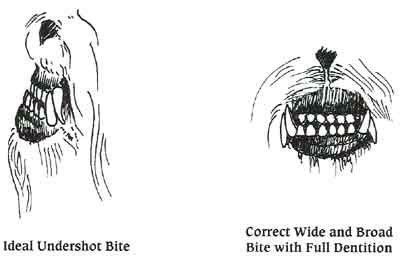 BITE – Undershot. Jaw is broad and wide. A missing tooth or slightly misaligned teeth should not be too severely penalized. Teeth and tongue should not show when mouth is closed. [Fault: Overshot bite.] CLARIFICATION: This section of the standard should be read in conjunction with the section on muzzle. In judging whether a bite is too undershot, the muzzle should be viewed from the side as well. A bite that is too undershot, when viewed form the side, cannot be perpendicular, as required in the section on muzzle. If, when viewed from the side, the muzzle is tilted back giving a "scooped faced" appearance, the bite is too undershot, regardless of whether the teeth show. If the bite is level or overshot, the muzzle will fall away or recede.
BITE – Undershot. Jaw is broad and wide. A missing tooth or slightly misaligned teeth should not be too severely penalized. Teeth and tongue should not show when mouth is closed. [Fault: Overshot bite.] CLARIFICATION: This section of the standard should be read in conjunction with the section on muzzle. In judging whether a bite is too undershot, the muzzle should be viewed from the side as well. A bite that is too undershot, when viewed form the side, cannot be perpendicular, as required in the section on muzzle. If, when viewed from the side, the muzzle is tilted back giving a "scooped faced" appearance, the bite is too undershot, regardless of whether the teeth show. If the bite is level or overshot, the muzzle will fall away or recede.
The ideal undershot bite is one in which the outer surface of the upper teeth engages, or nearly engages, the inner surface of the lower teeth. This bite is often referred to as a "reverse scissors bite." The reference to "missing and slightly misaligned teeth" should not be used as an excuse to encourage poorly aliened teeth. It should be remembered that the Shih Tzu has shallowly rooted teeth and may loose a tooth at a relatively young age. The width of the jaw is more important than perfect dentition.
